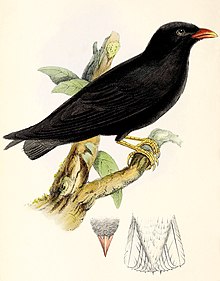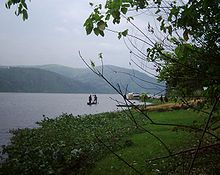African river martin
| African River Martin | |
|---|---|

| |
| Illustration from 1861 Ibis article. | |
| Scientific classification | |
| Kingdom: | |
| Phylum: | |
| Class: | |
| Order: | |
| Family: | |
| Genus: | |
| Species: | P. eurystomina
|
| Binomial name | |
| Pseudochelidon eurystomina | |

| |
| Red = breeding range in DRC Purple = present all year in Gabon Blue = Present all year in Republic of Congo | |
The African River Martin (Pseudochelidon eurystomina) is a passerine bird, one of two members of the river martin subfamily of the swallow family Hirundinidae. It is a medium-sized, mainly black-plumaged species with red eyes, a broad orange-red bill and a square tail. Its structural differences from most other swallows, including its robust legs and feet and stout bill, indicate that it should be placed with the Asian White-eyed River Martin in a separate subfamily.
It breeds along the Congo River and its tributary, the Ubangi. It nests in burrows in sand banks, and appears to be common within its restricted range, despite being caught in large numbers by the local population for food. It is migratory, wintering in coastal savannah in southern Gabon and the Republic of Congo. Many birds remain to breed in the wintering zones. This martin feeds on insects caught in the air and frequently walks on the ground rather than perching in trees. Due to a lack of detailed information about its population numbers, this species is classed as Data Deficient by the International Union for Conservation of Nature.
Taxonomy
When the African River Martin was first discovered in the 19th century, it was not thought to be a member of the swallow and martin family. German zoologist Gustav Hartlaub, who first described it in 1861, placed it with the rollers,[2] and later authors either placed it in its own family, or with the woodswallows. Study of the anatomy of the species by Lowe (1938) revealed that the species was closest to the swallows and martins, but sufficiently distinct to be placed in a separate subfamily Pseudochelidoninae.[3] [4] The genus name Pseudochelidon (Hartlaub, 1861) comes from the Ancient Greek language prefix ψευδο/pseudo, meaning "false," and χελιδον/chelidôn, meaning "swallow."[5] The species name reflects the superficial similarity to the rollers of the genus Eurystomus.[6]
The only other member of the subfamily is the White-eyed River Martin Pseudochelidon sirintarae, known only from one site in Thailand and possibly extinct. These two species possess a number of distinctive features which distinguish them from other swallows and martins, including their robust legs and feet, stout bill, large syrinx (vocal organ) and a different bronchial structure.[3] Genetic studies confirmed that the two river martins form a distinct clade from the typical swallows in the Hirundininae subfamily.[7]
The two river martins are in some ways intermediate between typical swallows and other passerines. The extent of their differences from other swallows and the wide geographical separation of these two martins suggest that they are relict populations of a group of species that diverged from the main swallow lineage early in its evolutionary history,[3] and that they may be the most primitive of the swallows.[8] Like other early hirundine lineages, they nest in burrows, rather than adopted nest holes or mud nests.[9]
Distribution and habitat

The African River Martin breeds along the Congo River and its tributary, the Ubangi in the Democratic Republic of the Congo, an area estimated at 47,000 km2 (18,150 mi2).[1] Its breeding habitat consists of forested rivers with islands that have sandy banks for burrowing. It is migratory, wintering in coastal savannah in southern Gabon and the Republic of the Congo; many birds stay to breed in the wintering areas.[1][3][10] Outside the breeding season it roosts in reed-beds or riverine vegetation.[1]
Description
The adult African River Martin is large, at 14 cm (5.6 in) long. It is mainly black with a silky blue-green gloss to the head, becoming distinctly green on the back and wing coverts. The underparts, other than the brownish under-wings, are purple-black, and the flight feathers are black. The tail is square and the midrib of the feathers extends slightly beyond the end of the webbing. This species has red eyes, pink eye-rings, and a broad orange red bill. The legs are brown.[3]
The sexes are similar, but juveniles are duller and have sooty brown heads. The moult to adult plumage takes place in the wintering areas and is largely complete by October. This species gives a short chee chee or similar call, and flocks call together, cheer-cheer-cheer. This martin is very vocal during migration, giving harsh gull-like calls. The flight is strong and fast, interspersed with glides.[3]
Behaviour
The habitat requirement of this species consists of forested rivers with sandbanks for breeding. The breeding season is from December to April when the river is low. This species breeds in large colonies (sometimes with Rosy Bee-eaters in Gabon) of up to 800 birds, each pair excavating a 1–2 m (39–78 in) long tunnel in the sandbars. The pocket at the end of the tunnel has a few twigs and leaves to serve as a nest, onto which two to four unspotted white eggs are laid. The eggs measure 21.9–26.0 x 16.4–18.2 mm (0.86–1.0 x 0.65–0.72 in). The incubation and fledging times are unknown, although it is believed that both parents care for the nestlings.[3]
It rarely perches on the breeding grounds and will walk on the ground; however, wintering birds regularly perch on treetops, wires and roofs. It has chasing flight displays, and it also displays on the ground, though the function of these displays is uncertain.[3] The African River Martin feeds in flocks over rivers and forests, often far from water, on insects, mainly taking winged ants.[11]
Status
The total population size of the African River Martin is unknown. In the late 1980s, it appeared to be common, if local, and large numbers were seen on migration in Gabon. However, it is particularly poorly known in the Democratic Republic of the Congo (DRC), and it is not known if there is any relationship between the birds breeding in the DRC and those breeding in coastal areas of Gabon and Congo. A flock of 15,000 birds was seen in 1997, and a mixed flock with Rosy Bee-eater Merops malimbicus was estimated at 100,000 birds. Several hundred birds were also seen at Conkouati-Douli National Park in 1996. Nevertheless, due to the lack of detailed information, the species is classed by the IUCN as Data Deficient.[1]
In the 1950s, the species was caught and eaten in large quantities in the DRC by the local population, and this practice could be increasing. Breeding colonies in river sandbars are liable to flooding,[1] but thousands of birds were breeding on the grasslands east of Gamba as recently as 2005.[12]
References
- ^ a b c d e f Template:IUCN
- ^ a b Template:De icon Hartlaub, Gustav (1861). "Ueber einige neue Vögel Westafrica's". Journal für Ornithologie. 9 (1): 12. doi:10.1007/BF02002444.
{{cite journal}}: Cite has empty unknown parameters:|month=and|coauthors=(help) Cite error: The named reference "Hartlaub" was defined multiple times with different content (see the help page). - ^ a b c d e f g h Turner, Angela K (1989). A handbook to the swallows and martins of the world. Bromley: Christopher Helm. pp. 85–86. ISBN 0-7470-3202-5.
{{cite book}}: Unknown parameter|coauthors=ignored (|author=suggested) (help) - ^ Lowe, P. R. (1938). "Some anatomical notes on the genus Pseudochelidon Hartlaub with reference to its taxonomic position". Ibis. 2: 429–437.
- ^ "Scientific bird names explained". uk.r.b. Archived from the original on 9 December 2007. Retrieved 2008-01-03.
{{cite web}}: Unknown parameter|deadurl=ignored (|url-status=suggested) (help) - ^ Hartlaub, Gustav (1861). "Dr G Hartlaub on a new bird from W Africa". Ibis. 3 (12): –.
{{cite journal}}: Cite has empty unknown parameter:|coauthors=(help); Unknown parameter|month=ignored (help)CS1 maint: extra punctuation (link) - ^ Sheldon, Frederick H (2005). "Phylogeny of swallows (Aves: Hirundinidae) estimated from nuclear and mitochondrial DNA". Molecular phylogenetics and evolution. 35 (1): 254–270. doi:10.1016/j.ympev.2004.11.008. PMID 15737595.
{{cite journal}}: Unknown parameter|coauthors=ignored (|author=suggested) (help); Unknown parameter|month=ignored (help) - ^ Olson, S L (1973). "A classification of the Rallidae". Wilson Bulletin. 65: 381–416.
{{cite journal}}: Cite has empty unknown parameters:|month=and|coauthors=(help) - ^ Winkler, David W (1993). "Evolution of nest construction in swallows (Hirundinidae): A molecular phylogenetic perspective" (PDF). Proceedings of the National Academy of Sciences USA. 90: 5705–5707. doi:10.1073/pnas.90.12.5705. PMC 46790. PMID 8516319.
{{cite journal}}: Unknown parameter|coauthors=ignored (|author=suggested) (help); Unknown parameter|month=ignored (help) - ^ Rand, A L (1959). "Birds from Gabon and Moyen Congo". Fieldiana: Zoology. 41 (2): 223–411.
{{cite journal}}: Unknown parameter|coauthors=ignored (|author=suggested) (help) - ^ Fry, C H (1992). "Myrmecophagy by Pseudochelidon eurystomina and other African birds". Bulletin of the British Ornithologists' Club. 112A: 87–97.
{{cite journal}}: Unknown parameter|month=ignored (help) - ^ Angehr, G R (2005). "Significant records and annotated site lists from bird surveys in the Gamba Complex, Gabon" (PDF). Malimbus. 27: 72.
{{cite journal}}: Unknown parameter|coauthors=ignored (|author=suggested) (help); Unknown parameter|month=ignored (help)
External links
- African River Martin videos on the Internet Bird collection

